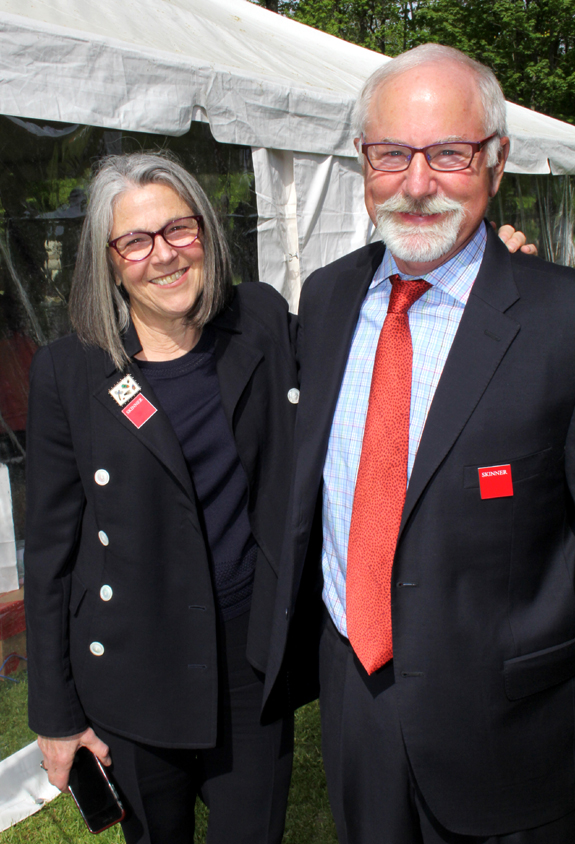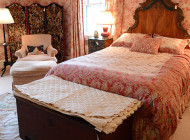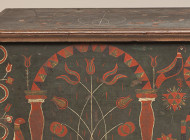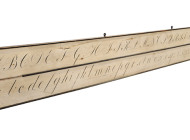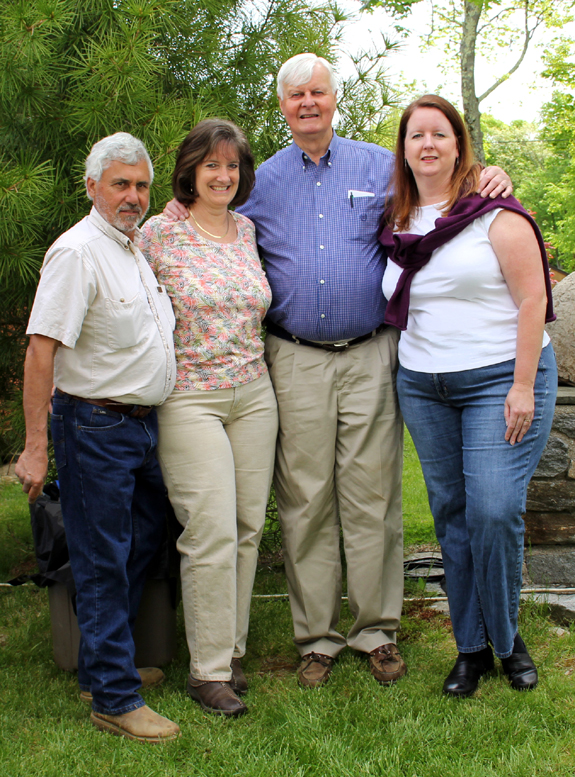
Lew Scranton, center, with his daughters Abigail and Rebecca, left and right, and son-in-law Carmine Patrizio.
Review and Onsite Photos by Laura Beach.
Additional photos courtesy Skinner Inc.
KILLINGWORTH, CONN. — Lewis Scranton wanted an old-fashioned Americana auction and he got one. The May 21 event unfolded on a beautiful Saturday morning on the broad, well-kept lawn circling the brick-red Cape that Scranton and his late wife, Janet, restored to perfection. Scranton’s family was there to cheer on the 79-year-old antiques dealer, whose personal collection came under the hammer.
Skinner Inc left nothing to chance in its graceful presentation, one that honored Scranton while celebrating the firm’s own rustic beginnings and the Americana field at large. Some of the planning came down to Scranton himself, who insisted on an onsite sale with runners, but no reserves or estimates. The auction was the culmination of a promise made by Stephen L. Fletcher, executive vice president and head of Skinner’s Americana department, to Scranton, with whom he had enjoyed working over the years.
“When Skinner first came down here to look, I told them how I wanted the sale run. I had a figure in mind. They came in with a lower estimate and I accepted. They couldn’t have done a better job. They were wonderful, especially specialist Chris Fox. I think I did my kids a favor by selling now. I knew what to do. My children would not have,” said Scranton. Though he will never know for sure, he believes the lack of a buyer’s premium increased competition and lifted prices overall. Total sales reached $1.04 million, with prices going higher than expected on some smaller items but falling short on a few big-ticket pieces.
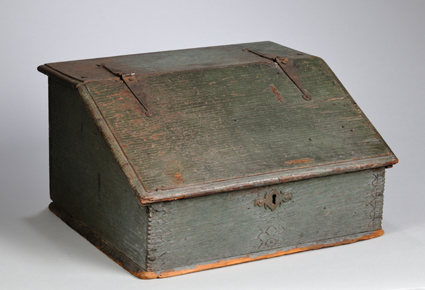
This 20-inch wide New England desk box was exquisitely understated. Dating from the Seventeenth Century, it had blue-green paint, chip-carved corners and subtle punchwork decoration. It went to David Wheatcroft for $20,000.
Two conjoined tents — one for seating, the other viewing merchandise — were comme il faut, with strings of electric lights and a station for Skinner Live, the firm’s proprietary online bidding platform. Every seat was taken, the audience a mix of collectors and dealers, many of them Scranton’s longtime friends and colleagues. Connecticut dealer Penny Dionne likened the affair to a class reunion.
“It was tent sales like this that made me fall in love with auctions many years ago,” a customer told Steve Fletcher. Far from a casual accumulation of family heirlooms, Scranton’s assemblage represented nearly 60 years of assiduous collecting in a well-defined niche: early New England furniture and accessories, much of it from coastal Connecticut.
As Skinner noted in its catalog introduction, “Lew’s focus has been on the utilitarian objects of primarily the Eighteenth and early Nineteenth Century. He loves the simplicity and functionality of their designs. His fondness for these objects is further rooted in the fact that they tell a story about the lives of everyday people. During our many visits with Lew, it was clear that his collection was an integral part of his life.”
“The sale was tremendously uplifting,” said Fred Giampietro, a New Haven, Conn., dealer who did a substantial trade with Scranton over the years. “There were more people there than I’ve seen in a long time. People in their forties and fifties were buying. It’s a shot in the arm for the Americana market. Lew did a great thing.”
As evidence of robust prices, Giampietro said he wanted six things, but only got two. One, a great buy at $6,500, was a rare circa 1825–35 cobalt decorated stoneware gemel jug, 10 inches tall, decorated with an incised fish and bird, and impressed in multiple places with the name of its maker, Absalom Stedman and Frederick Seymour of New Haven, Conn.
In partnership with Michael Whittemore, Giampietro bought back, for $17,000, an early Eighteenth Century black painted oval-top tavern table with handsome turnings and a single drawer. He sold Scranton the piece in 1987.
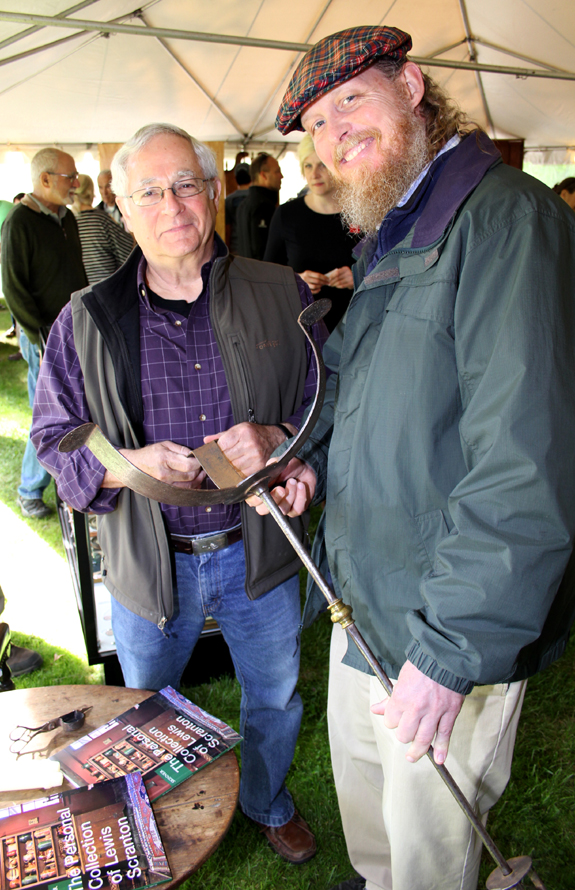
Colchester, Conn., dealers Arthur Liverant and Kevin Tulimieri inspect the base of an Eighteenth Century two-light iron and brass candlestand with Norwich, Conn., provenance that brought $36,000.
“I was representing more than one person and also buying for myself,” said Massachusetts dealer David Wheatcroft, buyer of several of the day’s top lots, one of which was an early Eighteenth Century iron and brass adjustable two-light stand for $36,000.
“You don’t often see them as complete or as beautifully designed,” said Wheatcroft. He paid $18,000 for a late Eighteenth Century child’s settle in red paint, $20,000 for a blue-green desk box with delicate punched decoration reminiscent of designs on early silver and $31,000 for a signed Silas Hoadley clock house in a spectacularly paint decorated case by Thomas Matteson of South Shaftsbury, Vt.
“To me, heart and crown chairs are icons of Connecticut furniture. These chairs date to the Colonial era, to circa 1730-40. They honor the crown,” said Colchester, Conn., dealer Arthur Liverant, pleased with his purchase of three such chairs from Scranton’s collection.
Scranton loves redware, so much so that he sold an important collection of it a little over a decade ago before reassembling a second group of mostly New England pieces. An ovoid Maine jar, $11,000, led an assortment of pieces distinguished by their alluring shapes and gorgeous glazes. Dishes inscribed in yellow slip with names and humorous phrases included one marked “Washington + Lafayette,” $13,000.
Scranton’s affection for silhouettes was shared by bidders, among them his friend, neighbor and customer Sallie Riblet and a persistent — and as yet unidentified — internet buyer on Skinner Live. Top honors went to a profile portrait of a man, $8,000, signed “J.A. Davis October 20th 1832/1832.” Attributed to James Hosley Whitcomb (1806–1849) of New Hampshire, circa 1834, and housed in a paint decorated frame, the portrait of young Harvey Dudley reached $7,500. Scranton’s favorite silhouette was a double portrait, $7,500, of Alpheus Rice and Huldah Call, married in 1805.
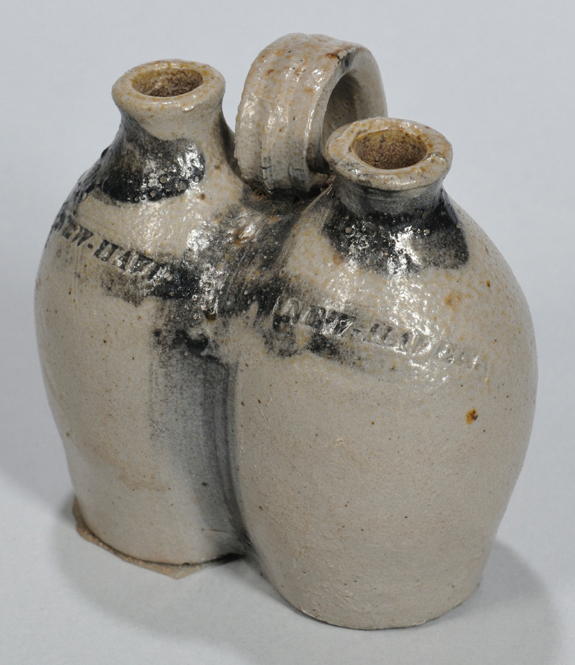
Only 3 inches tall, this sweetheart of a stoneware gemel jug is attributed to Absalom Stedman and Frederick Seymour of New Haven, Conn., circa 1825–35. Marked “New-Haven,” it brought $11,000.
For some time now the market has favored smaller, more easily displayed pieces over large or uncomfortable furniture, a trend as much about shifting taste as changing demographics. In this context, it was hardly surprising when a small splint basket painted a winning shade of blue surpassed expectation to sell for $7,500. At very least, said Fred Giampietro, “It should make someone looking at a $2,500 basket inclined to grab it.”
Seated several rows from the stage, Scranton displayed little emotion as the hammer fell on his life’s work. He admits feeling a pang just before the auction got underway. “The house was shockingly empty after Skinner removed everything to the tent. They took everything out in an hour and a half. I almost wanted to move stuff into the house again, it looked so great.”
Late Sunday morning, Scranton’s children returned to help him refurnish his house with inventory from his shop and carriage shed. The dealer, who plans to remain in business, albeit on a curtailed schedule, says, “We brought in five pickup loads. It’s beginning to resemble a house again. I’m the type who has to have old stuff around to look at.”
For additional information, www.skinnerinc.com or 617-350-5400.
[slideshow_deploy id=’1000269248′]
